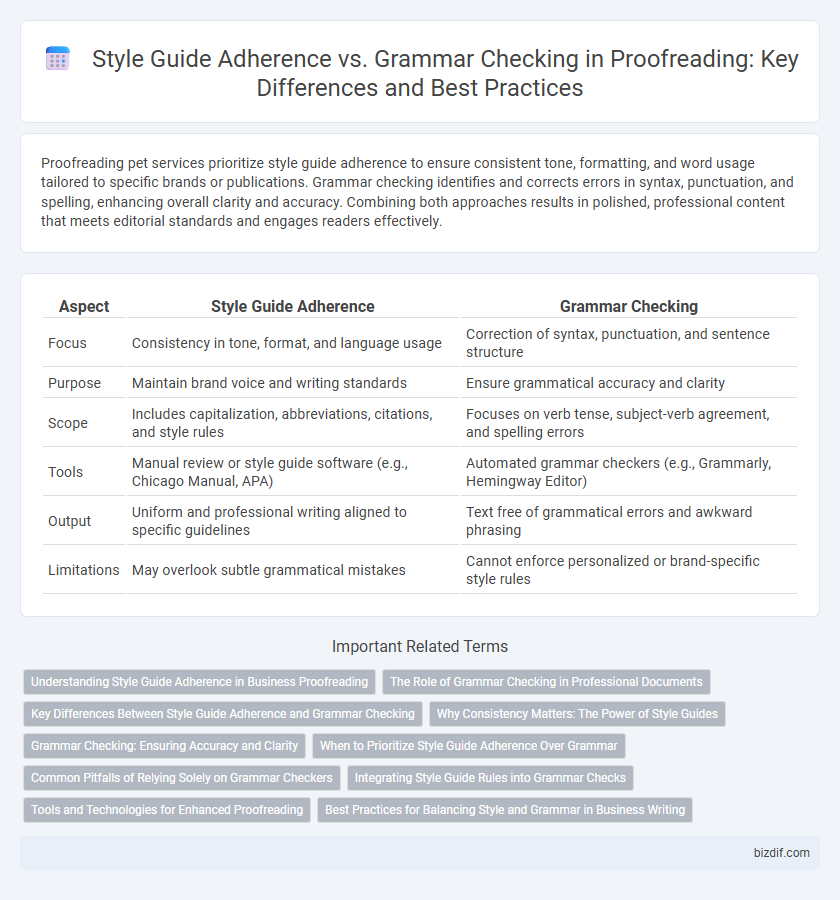Proofreading pet services prioritize style guide adherence to ensure consistent tone, formatting, and word usage tailored to specific brands or publications. Grammar checking identifies and corrects errors in syntax, punctuation, and spelling, enhancing overall clarity and accuracy. Combining both approaches results in polished, professional content that meets editorial standards and engages readers effectively.
Table of Comparison
| Aspect | Style Guide Adherence | Grammar Checking |
|---|---|---|
| Focus | Consistency in tone, format, and language usage | Correction of syntax, punctuation, and sentence structure |
| Purpose | Maintain brand voice and writing standards | Ensure grammatical accuracy and clarity |
| Scope | Includes capitalization, abbreviations, citations, and style rules | Focuses on verb tense, subject-verb agreement, and spelling errors |
| Tools | Manual review or style guide software (e.g., Chicago Manual, APA) | Automated grammar checkers (e.g., Grammarly, Hemingway Editor) |
| Output | Uniform and professional writing aligned to specific guidelines | Text free of grammatical errors and awkward phrasing |
| Limitations | May overlook subtle grammatical mistakes | Cannot enforce personalized or brand-specific style rules |
Understanding Style Guide Adherence in Business Proofreading
Understanding style guide adherence in business proofreading ensures consistent brand voice and professional communication by strictly following organizational rules on tone, terminology, and formatting. Unlike basic grammar checking that focuses on correcting syntax and punctuation errors, style guide adherence aligns documents with industry-specific standards and corporate identity. This precision reduces misinterpretations and enhances credibility in formal business correspondence.
The Role of Grammar Checking in Professional Documents
Grammar checking plays a crucial role in professional documents by ensuring clarity, accuracy, and consistency in language usage, which enhances overall readability and credibility. Unlike style guide adherence that emphasizes specific formatting and stylistic preferences, grammar checking focuses on eliminating errors such as subject-verb agreement, punctuation mistakes, and sentence structure issues. Effective grammar checking tools integrated with professional editing workflows help maintain high-quality communication standards, reducing the risk of misinterpretations and improving the document's impact.
Key Differences Between Style Guide Adherence and Grammar Checking
Style guide adherence ensures consistency in tone, format, and usage according to specific organizational or publication standards, while grammar checking focuses on identifying and correcting syntactic and morphological errors such as punctuation, subject-verb agreement, and sentence structure. Style guides like APA, Chicago, or MLA provide detailed rules on citation, stylistic preferences, and layout that go beyond basic grammar to maintain brand voice and readability. Grammar checking tools primarily scan text for correctness but do not enforce these nuanced stylistic rules critical for professional and academic writing.
Why Consistency Matters: The Power of Style Guides
Consistency in writing enhances readability and professionalism, making style guide adherence crucial beyond basic grammar checking. Style guides provide a standardized framework for tone, punctuation, and formatting, ensuring uniformity across documents and teams. This uniformity builds trust with readers and reinforces brand identity by maintaining a consistent voice and presentation.
Grammar Checking: Ensuring Accuracy and Clarity
Grammar checking focuses on identifying and correcting errors in syntax, punctuation, and sentence structure to ensure accuracy and clarity in writing. It enhances readability by eliminating mistakes that could confuse the reader or distort meaning. Effective grammar tools provide real-time feedback, enabling writers to maintain consistent language standards and improve overall communication quality.
When to Prioritize Style Guide Adherence Over Grammar
Prioritizing style guide adherence over grammar checking is essential when maintaining consistent brand voice and tone, especially in corporate communications or published materials. Style guides often dictate specific word choices, formatting, and punctuation that align with organizational standards, which can override basic grammatical rules to preserve clarity and professionalism. When the goal is uniformity across documents or aligning with audience expectations, adherence to a style guide ensures cohesive and effective communication beyond mere grammatical correctness.
Common Pitfalls of Relying Solely on Grammar Checkers
Relying solely on grammar checkers often leads to overlooked style guide adherence, resulting in inconsistent tone, formatting errors, and misuse of specialized terminology. Common pitfalls include ignoring context-based language preferences and failing to capture nuances in punctuation and sentence structure mandated by style guides like APA, MLA, or Chicago. Comprehensive proofreading requires a blend of automated grammar checking and strict adherence to style guide rules to ensure professional, polished documents.
Integrating Style Guide Rules into Grammar Checks
Incorporating style guide rules into grammar checking enhances consistency and accuracy across all written content, ensuring adherence to specific organizational standards such as the AP Stylebook or Chicago Manual of Style. Advanced proofreading tools leverage natural language processing algorithms to identify deviations from established style guidelines while correcting grammatical errors simultaneously. This integration streamlines the editing process, reduces manual review time, and improves the overall quality of the text by maintaining both linguistic correctness and stylistic uniformity.
Tools and Technologies for Enhanced Proofreading
Advanced proofreading tools leverage AI-powered grammar checking algorithms alongside customizable style guide adherence features to ensure precise and consistent text quality. Technologies like Grammarly and ProWritingAid integrate NLP techniques to detect contextual errors and enforce style rules such as APA, MLA, or Chicago. Enhanced proofreading platforms combine machine learning models with real-time suggestions, improving accuracy and efficiency in professional editing workflows.
Best Practices for Balancing Style and Grammar in Business Writing
Balancing style guide adherence with grammar checking in business writing ensures clarity, professionalism, and consistency across all communications. Employing tools that integrate style rules with grammar analysis helps maintain brand voice while eliminating errors that could undermine credibility. Regularly updating style guides and training writers on their application promotes effective messaging aligned with organizational standards.
style guide adherence vs grammar checking Infographic

 bizdif.com
bizdif.com